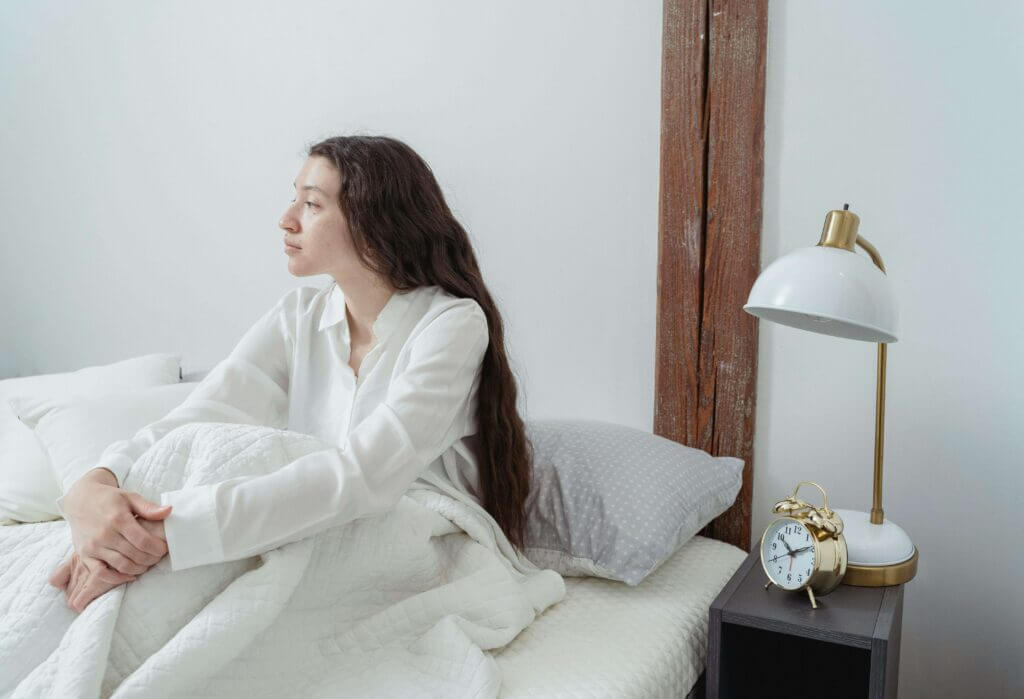Disclaimer: This post contains affiliate links, including links to Amazon. As an Amazon Associate, we earn from qualifying purchases at no additional cost to you. Thank you for supporting Low Tox & Thrive!
Did you know we spend about a third of our lives in the bedroom? That’s right—about 33% of the average lifespan is spent sleeping (or trying to). It makes sense, then, that creating a low tox bedroom is one of the most impactful changes you can make toward healthier living.
Whether it’s the materials in your mattress, the air quality in your room, or the bedding you cozy up with at night, it all plays a role. The good news? You have the power to improve your bedroom environment. In this post, we’ll break down how to do it.
Common toxins found in the bedroom
Let’s start with what we’re dealing with. Many common bedroom items contain potentially harmful substances that can affect your health over time. These toxins include:
- Volatile organic compounds (VOCs): Found in furniture, paint, and household cleaners, VOCs can irritate your respiratory system.
- Flame retardants: Added to mattresses and upholstered furniture, many flame retardants are linked to hormone disruption and other health issues.
- Dust and allergens: Your bedroom can be a haven for dust mites, pollen, and pet dander, contributing to allergies and poor air quality.
- Mold: Moisture in the bedroom can lead to mold growth, especially in humid climates.
6 steps to create a low tox bedroom
Creating a low tox bedroom doesn’t have to be complicated or expensive. Follow these six steps to start making your bedroom a cleaner, more health-supportive environment.
Step 1: Clean regularly (the non-toxic way)
Keeping your bedroom clean is one of the most effective ways to maintain a low tox home environment, but it’s important to be mindful of how you clean. Many conventional cleaning products contain harmful chemicals that can contribute to poor indoor air quality, irritate your skin, and even disrupt your hormones. Thankfully, there are non-toxic methods you can use to maintain a clean, healthy space without these risks.
Wet dust instead of using a dry cloth
When dusting surfaces like shelves, dressers, and nightstands, it’s common to use a dry cloth. However, dry dusting can actually make things worse by kicking up particles into the air, where they linger and can be inhaled. To avoid this, use a lightly dampened microfiber cloth to trap dust and prevent it from becoming airborne.
(Microfiber is especially effective because its fibers are designed to attract and hold onto dust, allergens, and dirt without the need for cleaning sprays.)
Vacuum with a HEPA filter
Vacuuming regularly is essential, especially if you have carpets or rugs, which tend to trap dust, dirt, and allergens. However, not all vacuums are created equal. Many traditional vacuums can actually blow dust and allergens back into the air, which defeats the purpose of cleaning. That’s where a HEPA filter (High-Efficiency Particulate Air filter) comes in.
A vacuum with a HEPA filter can capture 99.97% of particles as small as 0.3 microns, including dust mites, pollen, pet dander, and even mold spores. This means cleaner floors and cleaner air. If your vacuum doesn’t have a HEPA filter, consider upgrading or investing in a high-quality HEPA vacuum for better air quality.
Use a safe all-purpose cleaner
Many commercial all-purpose cleaners are packed with chemicals like bleach, ammonia, and synthetic fragrances that can irritate your skin and respiratory system. To avoid these toxins, opt for natural, non-toxic cleaners. There are plenty of eco-friendly cleaning brands on the market that use plant-based ingredients (like these options from Seventh Generation, PathoPure, and Aunt Fannie’s), but you can also make your own cleaner at home.
Avoid harsh carpet cleaners
Carpets and rugs are a common source of trapped dust, dirt, and even chemicals from previous cleaners. While it’s important to keep them clean, many commercial carpet cleaners are loaded with harsh chemicals that leave behind residues, which can linger in the fibers and be inhaled. Instead of using these products, try these non-toxic DIY alternative for spot cleaning or freshening up your carpets:
- For carpet odor: Sprinkle baking soda over the carpet, let it sit for 15-20 minutes (or longer for deeper odors), and then vacuum it up. Baking soda helps absorb odors and refreshes the carpet without any harmful chemicals.
- For stains or spot cleaning: Mix baking soda with water to create a paste, apply it to the stain, and let it dry before vacuuming. You can also mix baking soda with vinegar for an even more powerful, natural cleaner.
Wash your bedding with a non-toxic laundry detergent
We spend a lot of time in direct contact with our bedding, so it’s crucial to wash your sheets, pillowcases, and blankets with a safe, non-toxic detergent. Traditional laundry detergents often contain synthetic fragrances, phosphates, and harsh surfactants, which can leave chemical residues on your bedding. These residues can irritate your skin, disrupt hormones, and contribute to indoor air pollution.
To avoid these issues, look for plant-based, fragrance-free laundry detergents that are free from harsh chemicals (like these from Molly’s Suds and ECOS).
Step 2: Choose a safe mattress
Your mattress is one of the most important investments for a low tox bedroom. Here are some things to look for when choosing a non-toxic option:
Organic cotton, wool, and GOLS certified organic latex
These natural materials are free from pesticides, chemical treatments, and harmful synthetic additives. Organic cotton and wool are breathable, moisture-wicking, and hypoallergenic, which makes them great for maintaining a clean and comfortable sleep environment. GOLS (Global Organic Latex Standard) certified organic latex ensures that the latex used is sustainably sourced and free from toxic chemicals. This organic latex mattress from Pure Green is a great option.
No chemical flame retardants
Many mattresses are treated with chemical flame retardants to meet fire safety standards, but these chemicals can pose serious health risks, such as hormone disruption and respiratory issues. Instead, look for mattresses that use natural wool as a flame barrier. Wool is naturally flame-resistant and meets safety regulations without the need for added chemicals.
Waterproof covers without PVC or vinyl
If you need a waterproof mattress protector, be mindful of the materials. PVC and vinyl often contain harmful chemicals like phthalates, which can leach into the air. Safer alternatives include covers made from cotton or polyethylene, which offer waterproof protection without exposing you to toxins. For example, here is one non-toxic cotton mattress protector option from Amazon.
Step 3: Choose safe linens
When it comes to creating a low tox bedroom, your bedding is just as important as your mattress. After all, your sheets, pillowcases, and blankets are in direct contact with your skin every night. Many conventional bedding materials are treated with pesticides, formaldehyde, and synthetic dyes, which can lead to off-gassing and long-term exposure to harmful chemicals. Choosing natural, non-toxic linens is a simple but effective way to reduce toxins in your sleeping environment. Here are some low tox options to consider:
Organic cotton sheets
Organic cotton is a fantastic option for bedding because it’s soft, breathable, and free from toxic pesticide residues. Conventional cotton is one of the most heavily sprayed crops, so switching to organic ensures that your sheets are made from cotton grown without harmful chemicals or synthetic fertilizers. Organic cotton sheets (like this set from Lane Linen) are also gentle on sensitive skin, making them an ideal choice for those prone to allergies or skin irritation.
Bamboo fiber sheets
Bamboo is another excellent material for low tox bedding. Bamboo grows quickly without the need for pesticides, making it a renewable, eco-friendly resource. Bamboo fiber sheets (like this set from Pure Bamboo) are naturally temperature-regulating, moisture-wicking, and hypoallergenic, making them a great option for people who tend to overheat at night or have sensitive skin. These sheets are also incredibly soft, with a silky texture that many people love.
Wool and organic cotton pillows
Wool is a natural, breathable material that’s naturally resistant to dust mites, mold, and mildew. It also helps regulate temperature, keeping you warm in winter and cool in summer. Organic cotton pillows are another great choice, offering a chemical-free option that’s soft and hypoallergenic. Both materials provide excellent support and comfort without the toxins found in synthetic pillows.
Step 4: Choose safe furniture
Furniture can be a hidden source of toxins, especially if it’s made from synthetic materials or treated with chemicals like VOCs and flame retardants. To create a low tox bedroom, opt for pieces made from natural, non-toxic materials.
Avoid particle board and MDF
Particle board and MDF are often treated with formaldehyde-based adhesives, which can off-gas harmful chemicals over time. Instead, choose **solid wood** furniture, which is more durable, sustainable, and doesn’t release toxins into the air.
Choose natural materials like wood and metal
Furniture made from solid wood (such as oak or maple) or metal (like stainless steel or iron) is a healthier alternative to synthetic materials. These options are durable and free from harmful off-gassing, making them ideal for a low tox bedroom.
Look for flame retardant-free options
Many upholstered furniture pieces contain chemical flame retardants, which can accumulate in dust and pose health risks. Instead, choose furniture that is free from flame retardants, or opt for natural materials like wool, which are naturally flame-resistant.
Step 5: Manage air quality
Improving air quality is a key element in maintaining a low tox bedroom. Since we spend a lot of time breathing in bedroom air while we sleep, ensuring it’s clean and free of pollutants can significantly impact our overall health and sleep quality. Here are some ways to freshen up your space naturally:
Open windows regularly
One of the simplest ways to improve air quality is to open your windows regularly. Even just 10-15 minutes a day can help remove stagnant air and introduce fresh outdoor air into your bedroom. This helps reduce the concentration of indoor pollutants like dust, VOCs, and mold spores, which can accumulate over time.
Add houseplants
Certain houseplants can naturally purify the air by filtering out toxins such as formaldehyde, benzene, and carbon monoxide. Plants like snake plants, spider plants, and peace lilies are particularly effective at removing these toxins while also providing fresh oxygen. A few strategically placed plants can enhance both the aesthetics and air quality of your bedroom.
Salt lamps
Himalayan salt lamps are often recommended as a natural way to improve air quality by releasing negative ions, which may help neutralize airborne pollutants such as dust, allergens, and even electromagnetic radiation. While there is limited scientific evidence to support these claims, many people enjoy the calming, warm glow these lamps emit, which can help create a more relaxing atmosphere in your bedroom.
Air purifiers
For a more powerful solution, a high-quality air purifier with a HEPA filter is an excellent choice. These devices are designed to remove small particles like dust, pet dander, pollen, and even some volatile organic compounds (VOCs) from the air, making it easier to breathe. Air purifiers are especially beneficial if you suffer from allergies, asthma, or live in a high-pollution area. Be sure to choose a model that doesn’t emit ozone or other harmful byproducts.
Essential oil diffusers
Instead of using artificial air fresheners, which can release harmful chemicals into your home, opt for a natural essential oil diffuser. Using essential oils like lavender, eucalyptus, or peppermint not only refreshes the room but also offers therapeutic benefits like stress relief and improved sleep. Make sure to choose 100% pure essential oils to avoid synthetic additives.
If you don’t have an essential oil diffuser, try one of these natural air freshener DIYs.
Step 6: Be mindful of light
Lighting plays a significant role in your sleep quality and overall health. The kind of light you’re exposed to before bed can either support or disrupt your body’s natural rhythms. Here’s how to use lighting to create a soothing, low tox bedroom environment.
Minimize blue light exposure
Blue light, which is emitted by screens and some LED bulbs, can interfere with your body’s natural production of melatonin, a hormone that helps regulate your sleep-wake cycle. To promote better sleep, try to reduce screen time an hour before bed or use blue light filters on your devices. Swapping out blue-toned lights for warm, soft lighting can also help create a more calming evening environment.
Switch to red or amber light
In contrast to blue light, red or amber light is more conducive to restful sleep. These tones don’t interfere with melatonin production, making them ideal for bedside lamps or nightlights. Using red light bulbs in your bedroom or a red light therapy lamp can help signal to your body that it’s time to wind down, creating a peaceful atmosphere for better rest.
Dim lights for relaxation
Even if you don’t switch to red light, dimming your bedroom lights in the evening can naturally encourage your body to transition into sleep mode. Gradually reducing the brightness of your lights helps signal your brain that it’s time to relax. Installing dimmer switches or using soft-toned lamps can help you control your lighting and create a cozy, low tox environment for winding down at night.
Low tox bedroom on a budget: What to do if you have no cash to spend
Creating a low tox bedroom doesn’t always require a big investment. If you’re on a tight budget, here are a few free changes you can make right now:
- Open your windows regularly to improve air quality.
- Wash your sheets and pillowcases more frequently with a safe detergent.
- Declutter your space to reduce dust buildup.
- Dust and vacuum more often using non-toxic methods.
- Plan your upgrades. If you know you’ll need to replace items in the future, make a list of what you want to swap out and when. Prioritize mattresses, linens, and cleaning products over time.
Turn your bedroom into a true sanctuary
Creating a low tox bedroom is a powerful way to take control of your health and well-being. By making small, intentional changes, you can transform your sleep environment into a toxin-free retreat.







